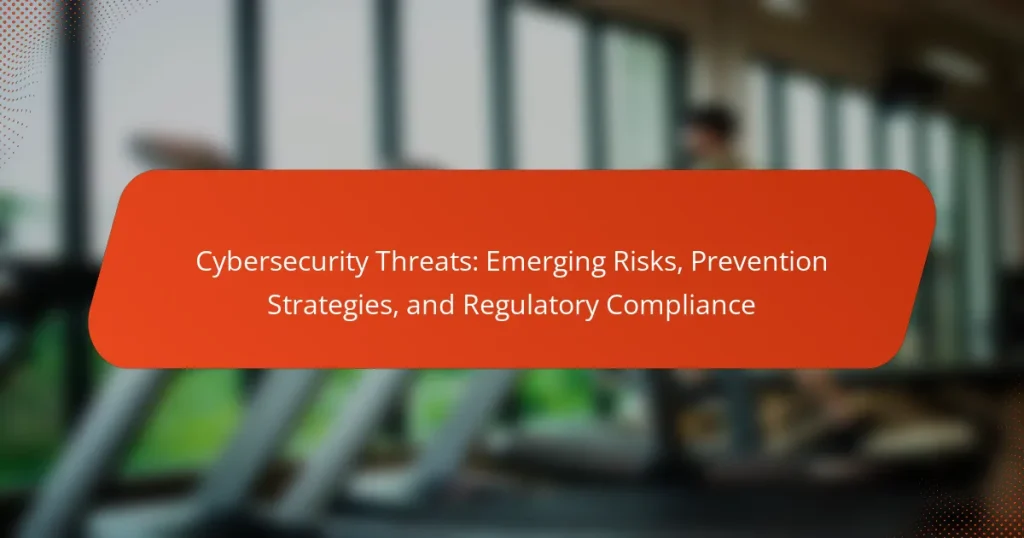Cybersecurity threats encompass malicious activities that compromise the confidentiality, integrity, or availability of information systems, including malware, phishing, ransomware, and denial-of-service attacks. The article examines emerging risks such as ransomware targeting critical infrastructure, supply chain vulnerabilities, and advanced persistent threats (APTs). It emphasizes the importance of implementing prevention strategies like regular software updates, employee training, and strong password policies to mitigate these threats. Additionally, the article highlights the significance of regulatory compliance, detailing how frameworks like GDPR and HIPAA enhance data protection, reduce legal liabilities, and foster a culture of security within organizations.
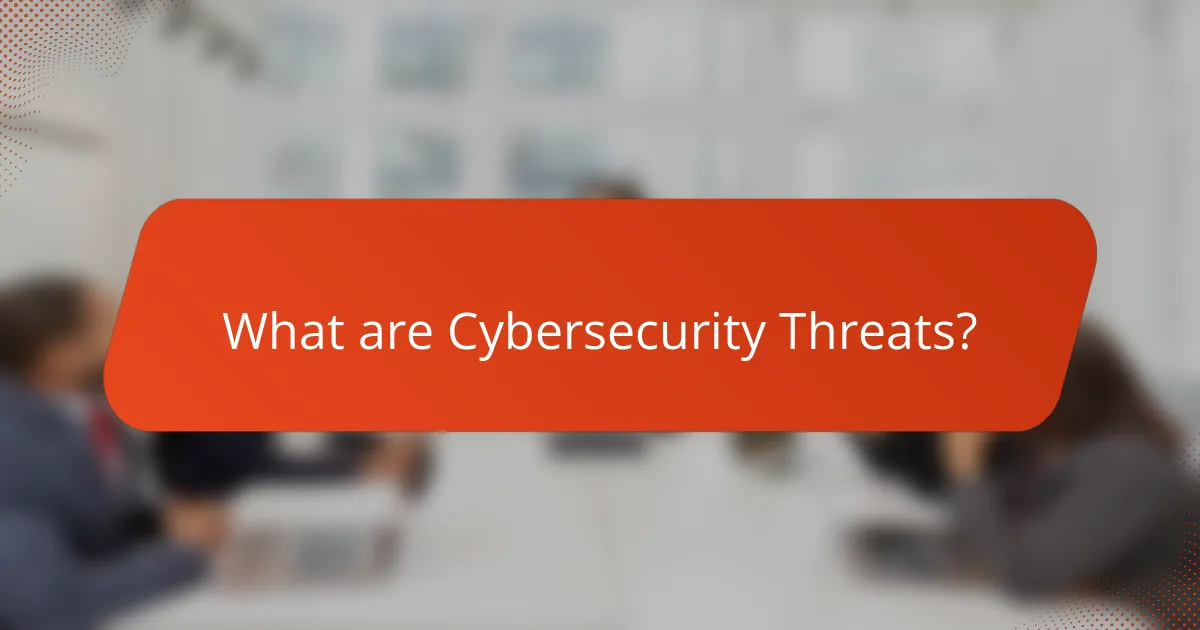
What are Cybersecurity Threats?
Cybersecurity threats are malicious activities aimed at compromising the confidentiality, integrity, or availability of information systems. These threats can include malware, phishing, ransomware, and denial-of-service attacks. According to Cybersecurity & Infrastructure Security Agency (CISA), malware is software designed to disrupt or damage systems. Phishing involves tricking individuals into revealing sensitive information. Ransomware encrypts data and demands payment for its release. Denial-of-service attacks overwhelm systems, making them unavailable. The increasing frequency of these threats highlights the need for robust cybersecurity measures. In 2021, the FBI reported a 69% increase in ransomware attacks compared to the previous year.
How do Cybersecurity Threats evolve over time?
Cybersecurity threats evolve over time due to advancements in technology and tactics used by cybercriminals. As technology progresses, new vulnerabilities emerge, making systems more susceptible to attacks. For example, the rise of cloud computing has introduced new threat vectors like data breaches and account hijacking. Additionally, cybercriminals adapt their techniques based on the effectiveness of existing security measures.
Ransomware attacks have become increasingly sophisticated, often leveraging encryption methods that make data recovery difficult. The emergence of artificial intelligence has also enabled attackers to automate their strategies, increasing the scale and speed of attacks.
According to the Cybersecurity & Infrastructure Security Agency (CISA), the frequency and complexity of cyber threats have significantly increased over the past decade. In 2021, ransomware attacks surged by 150% compared to the previous year, highlighting the evolving nature of these threats.
Furthermore, the COVID-19 pandemic accelerated the shift to remote work, leading to a rise in phishing attacks targeting remote employees. This demonstrates how external factors can influence the evolution of cybersecurity threats.
What factors contribute to the emergence of new Cybersecurity Threats?
The emergence of new cybersecurity threats is influenced by various factors. Rapid technological advancements create vulnerabilities in systems. Increased use of the Internet of Things (IoT) expands attack surfaces for malicious actors. The rise of remote work has led to less secure networks and endpoints. Cybercriminals continuously adapt their tactics to exploit human behavior, such as phishing. Additionally, geopolitical tensions can motivate state-sponsored attacks. The lack of robust cybersecurity measures in organizations further facilitates the emergence of threats. According to the Cybersecurity & Infrastructure Security Agency (CISA), over 18,000 vulnerabilities were reported in 2020 alone, highlighting the growing risk landscape.
How do technological advancements impact Cybersecurity Threats?
Technological advancements significantly increase cybersecurity threats. New technologies create vulnerabilities that attackers exploit. For instance, the rise of IoT devices has led to more entry points for cybercriminals. In 2021, it was reported that IoT vulnerabilities increased by 300% compared to the previous year. Additionally, advancements in artificial intelligence enable sophisticated attacks, such as automated phishing schemes. Cybersecurity experts note that AI can generate convincing fake communications. Furthermore, the shift to cloud computing raises concerns about data security and privacy. A study by McKinsey found that 30% of organizations experienced a cloud-related security incident. These factors illustrate that while technology advances, so do the methods and frequency of cyber threats.
What are the different types of Cybersecurity Threats?
The different types of cybersecurity threats include malware, phishing, ransomware, and denial-of-service attacks. Malware refers to malicious software designed to harm or exploit devices. Phishing involves deceptive attempts to obtain sensitive information through fraudulent communications. Ransomware is a type of malware that encrypts data and demands payment for its release. Denial-of-service attacks overload systems, making them unavailable to users. Additional threats include insider threats, where employees misuse access, and advanced persistent threats, which involve prolonged targeted attacks. According to the Cybersecurity and Infrastructure Security Agency, these threats continue to evolve, affecting organizations globally.
What is the difference between malware and phishing attacks?
Malware and phishing attacks are distinct types of cybersecurity threats. Malware refers to malicious software designed to harm, exploit, or otherwise compromise computer systems. Examples of malware include viruses, worms, and ransomware. Phishing attacks, on the other hand, involve deceptive attempts to acquire sensitive information, such as usernames and passwords, by impersonating trustworthy entities. Phishing often occurs through emails or fake websites that appear legitimate. The primary difference lies in their approach: malware directly infects systems, while phishing seeks to trick users into voluntarily providing information. According to the Cybersecurity and Infrastructure Security Agency (CISA), both are critical threats, but they use different methods to achieve their objectives.
How do ransomware attacks operate?
Ransomware attacks operate by infiltrating a victim’s system and encrypting their files. Attackers typically use phishing emails or malicious downloads to gain access. Once inside, the ransomware encrypts files, rendering them inaccessible. The victim is then presented with a ransom note, demanding payment for decryption. Payment is often requested in cryptocurrency to maintain anonymity. According to a report by Cybersecurity Ventures, ransomware damages are projected to reach $20 billion by 2021. This highlights the growing threat and financial impact of such attacks on individuals and organizations.
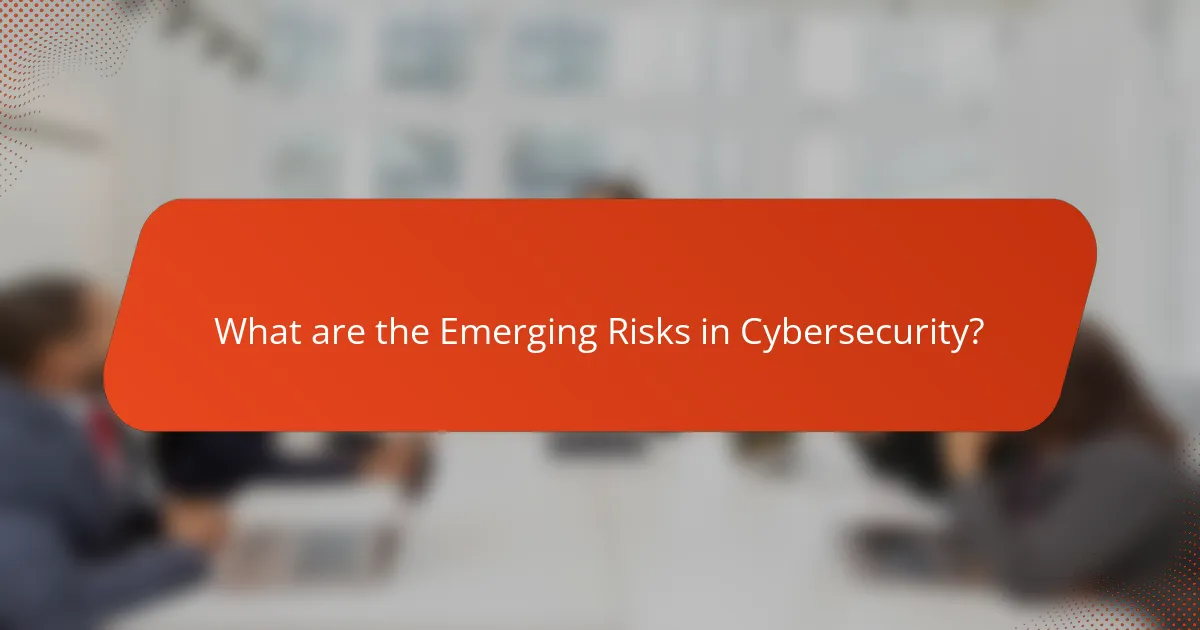
What are the Emerging Risks in Cybersecurity?
Emerging risks in cybersecurity include ransomware attacks, supply chain vulnerabilities, and advanced persistent threats (APTs). Ransomware attacks are increasingly targeting critical infrastructure, with a notable rise of 300% in attacks reported in 2020. Supply chain vulnerabilities occur when third-party vendors are compromised, as seen in the SolarWinds breach affecting thousands of organizations. APTs involve sophisticated, long-term strategies by cybercriminals to infiltrate networks, posing significant risks to sensitive data. Additionally, the rise of remote work has increased exposure to phishing attacks, with a 220% increase in phishing attempts noted during the pandemic. These trends highlight the evolving landscape of cybersecurity threats.
What are the current trends in Cybersecurity Risks?
Current trends in cybersecurity risks include an increase in ransomware attacks, phishing schemes, and supply chain vulnerabilities. Ransomware attacks have surged, with a reported 150% increase in 2020 alone. Phishing schemes have evolved, targeting remote workers and exploiting COVID-19-related fears. Supply chain vulnerabilities have gained attention, especially after high-profile breaches like the SolarWinds attack. Additionally, the rise of Internet of Things (IoT) devices has expanded the attack surface for cybercriminals. The shift to cloud services has also introduced new risks, as misconfigurations can lead to data exposure. According to Cybersecurity Ventures, cybercrime is projected to cost the world $10.5 trillion annually by 2025. These trends highlight the evolving landscape of cybersecurity risks.
How does remote work influence Cybersecurity Risks?
Remote work increases cybersecurity risks significantly. Employees often access company systems from unsecured networks. This creates vulnerabilities that cybercriminals can exploit. According to a 2021 Cybersecurity Insiders report, 80% of organizations experienced an increase in cyber threats due to remote work. Phishing attacks have also surged, with a 400% increase reported during the pandemic. Additionally, the use of personal devices for work can lead to data breaches. Many employees lack cybersecurity training, further heightening risks. Organizations must implement robust security measures to mitigate these threats.
What role do IoT devices play in Cybersecurity Risks?
IoT devices significantly contribute to cybersecurity risks. These devices often have weak security features, making them vulnerable to attacks. Attackers can exploit these vulnerabilities to gain unauthorized access to networks. For example, the Mirai botnet attack in 2016 leveraged insecure IoT devices to launch a massive DDoS attack. Moreover, many IoT devices collect sensitive data, increasing the risk of data breaches. Inadequate software updates further exacerbate these risks. According to a report by Cybersecurity Ventures, IoT-related cybercrime damages are expected to reach $6 trillion annually by 2021. Thus, the proliferation of IoT devices poses substantial cybersecurity challenges.
What industries are most affected by Emerging Cybersecurity Risks?
The industries most affected by emerging cybersecurity risks include finance, healthcare, and retail. The finance sector faces threats due to sensitive financial data and transactions. Cyberattacks can lead to significant financial losses and data breaches. The healthcare industry is vulnerable because of patient data that requires protection under regulations like HIPAA. Cyber incidents can disrupt services and compromise patient safety. Retail businesses are targeted for customer payment information and personal data. Data breaches can damage brand reputation and customer trust. Other affected industries include energy, manufacturing, and government. Each of these sectors experiences unique challenges due to their reliance on technology and data.
How do Emerging Risks differ across various sectors?
Emerging risks differ across various sectors primarily due to their unique operational environments and regulatory landscapes. For instance, the healthcare sector faces risks related to patient data breaches and ransomware attacks. These threats can compromise sensitive medical information and impact patient safety. The financial sector, on the other hand, deals with risks such as fraud and identity theft, which can lead to significant monetary losses.
In the technology sector, emerging risks often involve intellectual property theft and supply chain vulnerabilities. These risks can hinder innovation and disrupt service delivery. The manufacturing sector encounters risks linked to industrial control systems being targeted, which can halt production and create safety hazards.
Additionally, the energy sector faces risks associated with infrastructure attacks, which can affect national security and public safety. Each sector’s specific characteristics shape the nature and impact of emerging risks, necessitating tailored prevention strategies and compliance measures.
What specific challenges do small businesses face regarding Emerging Risks?
Small businesses face significant challenges regarding emerging risks, particularly in cybersecurity. Limited resources hinder their ability to invest in advanced security measures. Many small businesses lack the expertise to identify and mitigate cyber threats effectively. The increasing sophistication of cyberattacks poses a constant threat to their operations. Compliance with evolving regulations adds another layer of complexity. Small businesses often struggle to keep up with the latest cybersecurity best practices. The financial impact of a data breach can be devastating, leading to potential closure. A recent study by the Ponemon Institute found that 60% of small businesses go out of business within six months of a cyberattack.
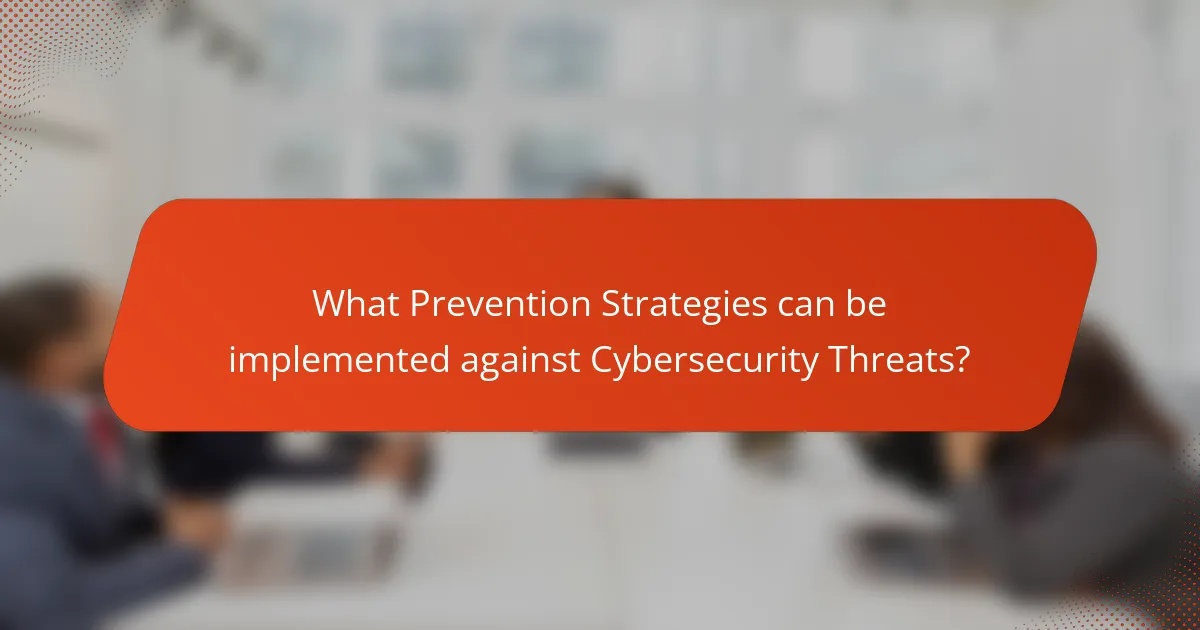
What Prevention Strategies can be implemented against Cybersecurity Threats?
Implementing prevention strategies against cybersecurity threats includes multiple measures. These strategies encompass regular software updates, which patch vulnerabilities. Employee training enhances awareness of phishing and social engineering attacks. Strong password policies, including multi-factor authentication, improve access security. Network segmentation limits the impact of breaches by isolating sensitive data. Regular security audits identify weaknesses in systems. Firewalls and intrusion detection systems monitor and block malicious activities. Data encryption protects sensitive information during transmission and storage. These strategies collectively reduce the risk of cyber incidents and enhance overall security posture.
How can organizations enhance their Cybersecurity posture?
Organizations can enhance their cybersecurity posture by implementing a multi-layered security strategy. This includes conducting regular risk assessments to identify vulnerabilities. Employee training on cybersecurity best practices is essential to mitigate human error. Utilizing advanced threat detection tools can help in early identification of potential breaches. Regular software updates and patch management are crucial for protecting against known vulnerabilities. Implementing strong access controls limits exposure to sensitive data. Organizations should also develop and test incident response plans to ensure preparedness for potential attacks. According to a 2021 report by Cybersecurity & Infrastructure Security Agency, organizations that adopt these strategies significantly reduce their risk of cyber incidents.
What are the best practices for employee training in Cybersecurity?
The best practices for employee training in cybersecurity include regular training sessions, practical exercises, and awareness programs. Regular training ensures that employees stay updated on the latest threats and security protocols. Practical exercises, such as simulated phishing attacks, help employees recognize and respond to real threats. Awareness programs promote a culture of security within the organization.
Additionally, training should be tailored to specific roles within the company. This ensures that employees receive relevant information pertinent to their job functions. Using real-world examples can enhance understanding and retention of security concepts.
Finally, ongoing assessments and feedback mechanisms are crucial. They allow organizations to measure the effectiveness of training and make necessary adjustments. According to a study by the Ponemon Institute, organizations that implement comprehensive training programs can reduce the risk of a data breach by up to 70%.
How can regular software updates mitigate Cybersecurity Threats?
Regular software updates mitigate cybersecurity threats by patching vulnerabilities. Software developers frequently identify security flaws in their products. They release updates to fix these flaws and enhance security. Applying these updates reduces the risk of exploitation by cybercriminals. For example, the 2020 Microsoft Exchange Server vulnerabilities affected thousands of organizations. Timely updates helped prevent breaches in many cases. Additionally, updates often include improved security features. This proactive approach strengthens overall system defenses against emerging threats. Regularly updating software is a critical practice for maintaining cybersecurity.
What technologies are effective in preventing Cybersecurity Threats?
Firewalls are effective in preventing cybersecurity threats. They monitor and control incoming and outgoing network traffic. Firewalls act as a barrier between trusted and untrusted networks. Intrusion Detection Systems (IDS) also play a vital role. IDS monitor network traffic for suspicious activities and alert administrators. Antivirus software protects against malware and viruses. It scans and removes malicious software from devices. Encryption technologies secure data by converting it into a coded format. This prevents unauthorized access during transmission. Multi-factor authentication adds an extra layer of security. It requires users to provide two or more verification factors. Regular software updates patch vulnerabilities and protect against threats. These technologies collectively enhance cybersecurity defenses.
How do firewalls and antivirus software work together?
Firewalls and antivirus software work together to enhance cybersecurity. Firewalls act as barriers between trusted internal networks and untrusted external networks. They filter incoming and outgoing traffic based on predefined security rules. Antivirus software scans files and programs for malware and viruses. It detects, quarantines, and removes malicious software.
When combined, firewalls prevent unauthorized access while antivirus software protects against malware. This layered security approach reduces the risk of breaches. For example, a firewall may block suspicious traffic, while antivirus software ensures that downloaded files are safe. Together, they provide comprehensive protection against various cyber threats.
What is the role of intrusion detection systems in Cybersecurity?
Intrusion detection systems (IDS) play a crucial role in cybersecurity by monitoring network traffic for suspicious activities. They analyze data packets and identify potential threats in real-time. IDS can detect unauthorized access attempts, malware, and policy violations. These systems generate alerts for security personnel to investigate further. According to a 2021 report by the Ponemon Institute, organizations using IDS significantly reduce breach detection time. Effective IDS implementation enhances an organization’s overall security posture.
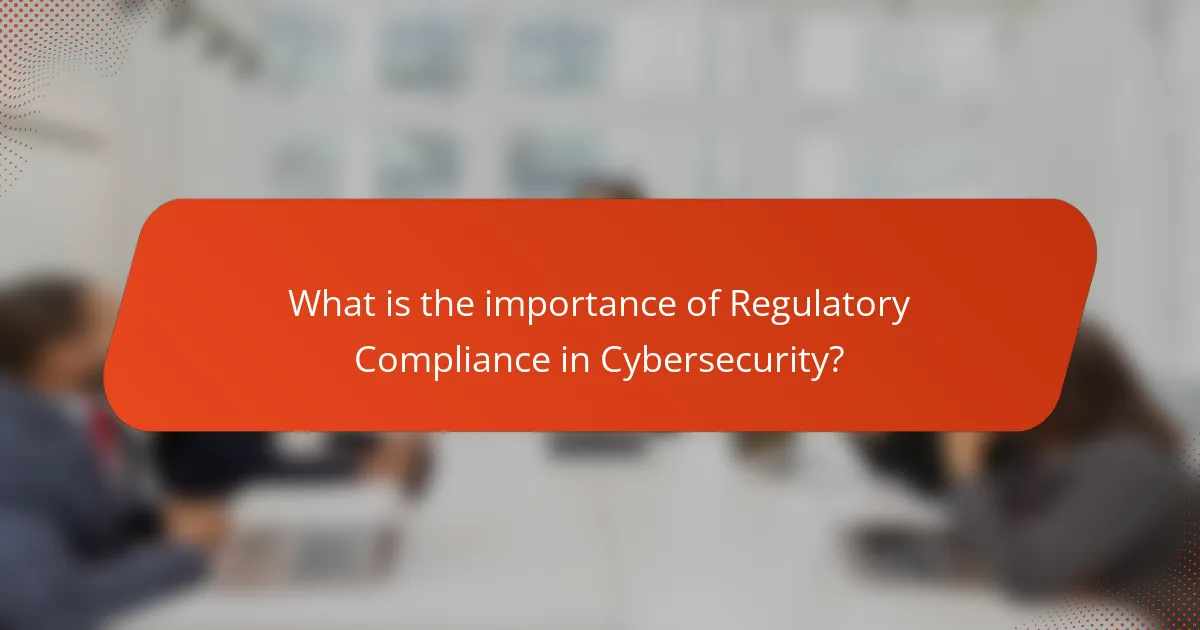
What is the importance of Regulatory Compliance in Cybersecurity?
Regulatory compliance in cybersecurity is crucial for protecting sensitive data and ensuring organizational integrity. It establishes a framework for organizations to follow, minimizing risks associated with data breaches. Compliance mandates, such as GDPR and HIPAA, provide guidelines for data protection and privacy. Following these regulations can lead to reduced legal liabilities and financial penalties. Statistics show that organizations with compliance measures in place experience fewer data breaches. Regulatory compliance also enhances customer trust, as clients feel safer sharing their information. Additionally, it promotes a culture of security within the organization, encouraging best practices among employees. Overall, regulatory compliance is essential for maintaining security and fostering a responsible business environment.
What are the key regulations governing Cybersecurity?
Key regulations governing cybersecurity include the General Data Protection Regulation (GDPR), the Health Insurance Portability and Accountability Act (HIPAA), and the Federal Information Security Management Act (FISMA). GDPR mandates data protection and privacy for individuals in the European Union. HIPAA sets standards for protecting sensitive patient health information in the healthcare sector. FISMA requires federal agencies to secure their information systems. These regulations aim to enhance data security and protect personal information across various industries.
How does GDPR impact Cybersecurity practices?
GDPR significantly impacts cybersecurity practices by enforcing strict data protection requirements. Organizations must implement appropriate technical and organizational measures to safeguard personal data. This includes conducting regular risk assessments and ensuring data encryption. GDPR mandates that data breaches be reported within 72 hours, increasing the urgency for robust incident response plans. Non-compliance can lead to substantial fines, reaching up to 4% of annual global turnover. Therefore, companies must prioritize cybersecurity to mitigate risks and comply with these regulations. This regulatory framework encourages a proactive approach to data security.
What are the consequences of non-compliance with Cybersecurity regulations?
Non-compliance with cybersecurity regulations can lead to significant legal and financial consequences. Organizations may face hefty fines imposed by regulatory bodies. For example, the General Data Protection Regulation (GDPR) can impose fines up to 4% of annual global turnover. Additionally, non-compliance can result in legal actions from affected parties. Companies may also suffer reputational damage, leading to loss of customer trust. This can affect long-term business relationships and revenue. Furthermore, non-compliance increases vulnerability to cyberattacks. Organizations may experience data breaches, leading to further financial losses and operational disruptions.
How can organizations ensure compliance with Cybersecurity regulations?
Organizations can ensure compliance with cybersecurity regulations by implementing a comprehensive cybersecurity program. This program should include regular risk assessments to identify vulnerabilities. Organizations must also establish clear policies and procedures that align with regulatory requirements. Training employees on cybersecurity best practices is essential for maintaining compliance. Regular audits should be conducted to evaluate adherence to these policies. Additionally, organizations should stay updated on changes in regulations to adapt their practices accordingly. Using tools for continuous monitoring can help detect compliance gaps in real-time. Following frameworks like NIST or ISO standards can provide structured guidance for compliance efforts.
What steps should be taken to conduct a Cybersecurity audit?
Identify the scope of the cybersecurity audit. This involves determining the systems, networks, and data to be evaluated. Next, gather relevant documentation such as security policies and previous audit reports. Conduct interviews with key personnel to understand current security practices. Assess existing security controls to identify vulnerabilities and gaps. Perform [censured] testing to simulate cyber attacks and evaluate defenses. Analyze the findings and compile a report detailing vulnerabilities and recommendations. Finally, present the audit results to stakeholders and develop an action plan for remediation.
How can documentation and reporting aid in maintaining compliance?
Documentation and reporting aid in maintaining compliance by providing a clear record of processes and actions taken. This enables organizations to demonstrate adherence to regulatory requirements. Accurate documentation helps track compliance activities and identifies areas needing improvement. Regular reporting ensures that compliance status is communicated to stakeholders. It also facilitates audits by providing necessary evidence of compliance efforts. According to a study by the International Association for Privacy Professionals, organizations with robust documentation practices are 30% more likely to maintain compliance. This highlights the effectiveness of thorough documentation in supporting compliance initiatives.
What practical tips can organizations follow to enhance Cybersecurity?
Organizations can enhance cybersecurity by implementing strong password policies. This includes requiring complex passwords that are regularly updated. Multi-factor authentication should also be enforced to add an extra layer of security. Regular software updates and patch management are essential to protect against vulnerabilities. Employee training on cybersecurity awareness is crucial to mitigate human error. Organizations should conduct regular security audits to identify and address weaknesses. Data encryption should be used to protect sensitive information. Lastly, incident response plans must be developed and tested to ensure quick recovery from breaches.
How can regular risk assessments improve Cybersecurity measures?
Regular risk assessments enhance cybersecurity measures by identifying vulnerabilities and potential threats. These assessments provide a structured approach to evaluating an organization’s security posture. They help in prioritizing risks based on their potential impact. Regular assessments ensure that security controls are effective and up-to-date. They also facilitate compliance with regulatory requirements, reducing legal and financial risks. Studies show that organizations conducting frequent risk assessments experience fewer security incidents. According to the 2021 Cybersecurity Almanac, companies that assess risks regularly are 50% less likely to suffer data breaches. This proactive approach leads to a more resilient cybersecurity framework.
What are the benefits of developing an incident response plan?
Developing an incident response plan enhances an organization’s ability to effectively manage cybersecurity incidents. It minimizes damage by providing a structured approach to detect, respond to, and recover from incidents. This plan facilitates faster identification of threats, which can reduce response time significantly. According to a study by Ponemon Institute, organizations with an incident response plan can reduce the cost of a data breach by an average of $1.23 million. Additionally, an incident response plan ensures compliance with regulatory requirements, reducing the risk of penalties. It also helps in maintaining customer trust by demonstrating preparedness and transparency in handling incidents. Overall, a well-developed plan is crucial for mitigating risks and ensuring business continuity.
Cybersecurity threats encompass malicious activities that compromise the confidentiality, integrity, or availability of information systems, including malware, phishing, ransomware, and denial-of-service attacks. The article explores the evolution of these threats, highlighting factors such as technological advancements, remote work, and IoT vulnerabilities that contribute to their emergence. It discusses various types of cybersecurity threats, the impact of regulatory compliance, and effective prevention strategies organizations can implement to enhance their cybersecurity posture. Additionally, it outlines the importance of employee training and regular risk assessments in mitigating risks and maintaining compliance with regulations like GDPR and HIPAA.
